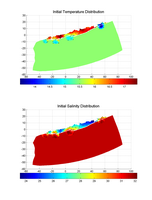Model
Forcing - Tides, Rivers, Bottom Fresh Water, Winds and Initial
Conditions
| Tides - Tides in the Mid-Atlantic Bight are dominated by the M2 component which represents approximately 85% of the tidal elevation variance along the southern coast of Long Island (Moody, et al., 1984). Inside the Bay at West Islip the M2 tidal component represents about 88% of the variance (Wong, 1986). Based upon these results, other observations of the much attenuated tides inside Great South Bay (Wong, 1982) and the simplicity of determining tidal-mean conditions in the model, the tidal forcing for the model is currently limited to the M2 component. The M2 tidal amplitudes and phases at the boundary of the model domain is provided by an ADCIRC model for the entire New York Bight. |
| Initial
Conditions - All the model runs started with the waters at rest. Initial temperatures and salinities were derived from the Suffolk County DEC observations at 21 stations in the Great South Bay and Moriches Bay (courtesy of Robert Nuzzi). The data for these stations were simply averaged to produce what was assumed to be climatological mean conditions even though the sampling was not uniform throughout the years or seasons. We do not have similar observations from Nassau County and so estimates of initial there were subjectively extrapolated from the Suffolk County data. In the offshore region outside the inlets the salinity and temperature were assumed uniform and set to 15.5oC and 31.5psu approximating the mean climatological conditions just outside Fire Island Inlet which was the only coastal location with long-term observations. |
 |